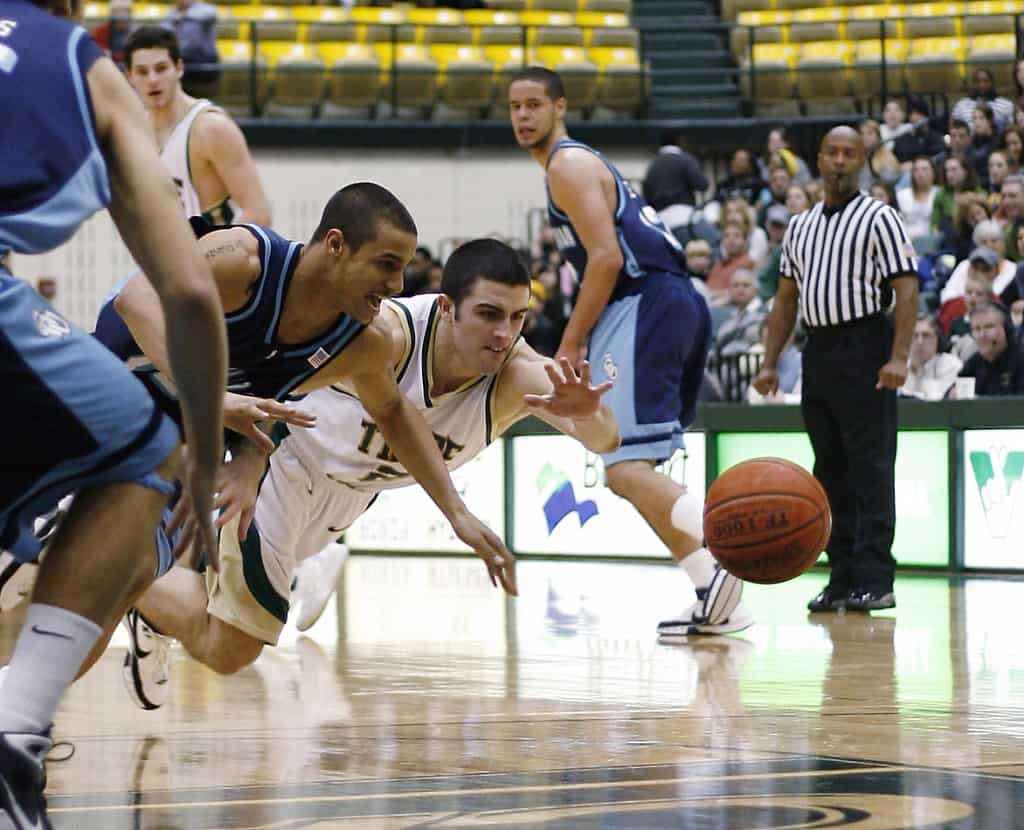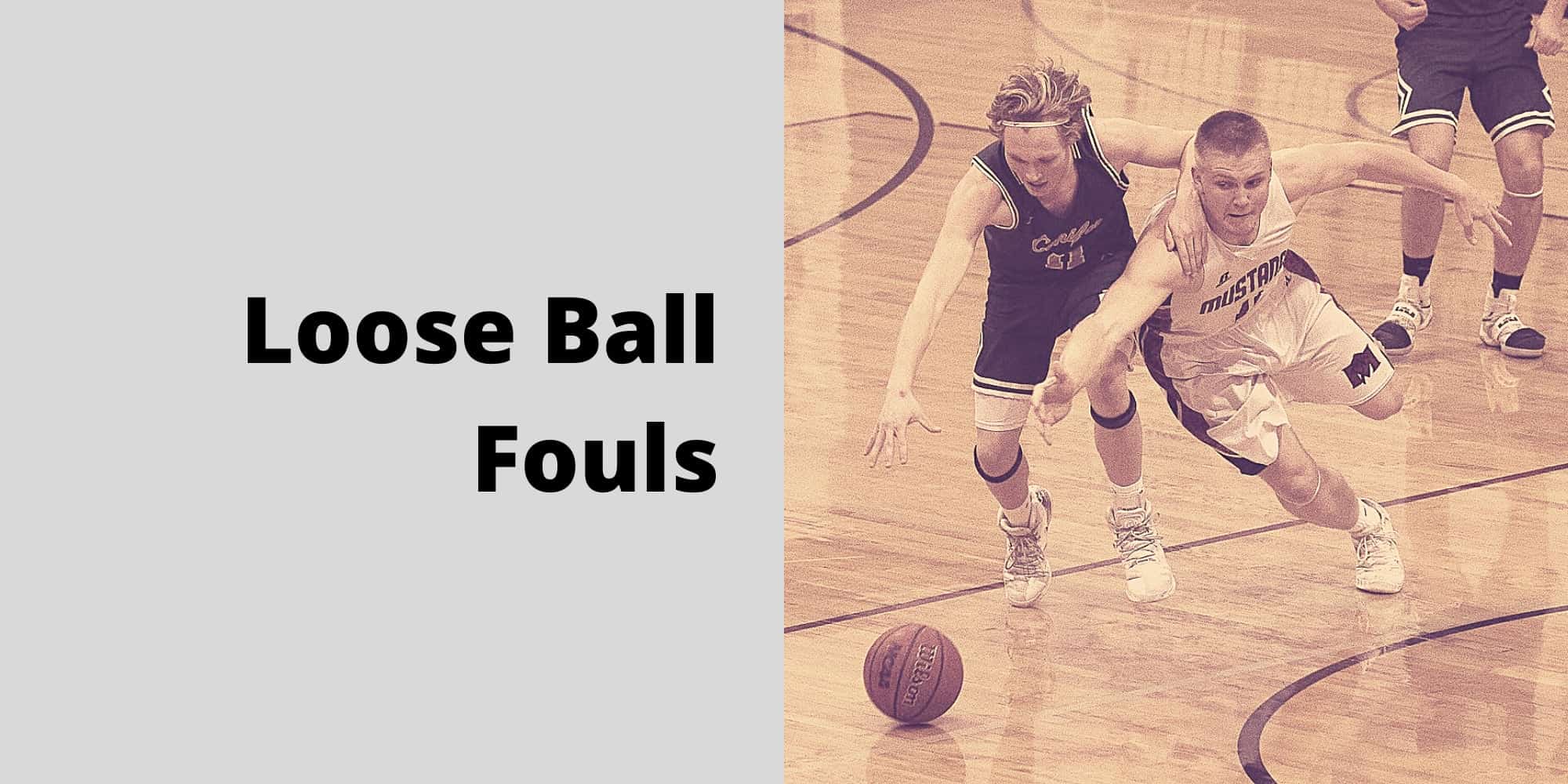You’ve been running up and down the court for a few possessions; the game has started to get physical and a little chippy.
You’re tired, but as you make your way back on defense, a teammate manages to swipe the ball from your opponent; the ball is loose!
With your eyes set on the loose ball that’s bouncing towards the edge of the court, you explode wildly towards it, trying to secure the steal for your team.
But without even realizing it, just as your fingertips graze the ball, you smash into another opponent, sending them flying!
As you crash to the floor, you can hear the whistle blow. As you look around, the ref comes over, pointing directly at you. You begin to complain, “What did I even do? No one even had the ball!”. As the respective teammates convene to pick you and your opponent up, you can hear the ref exclaim, “loose ball foul!”
This illustrates a simple example of a loose ball foul situation in a basketball game. Now that you have an example of what it might look like, let’s give this form of foul a proper definition.

Loose ball foul defined
In basketball, a loose ball foul is defined as a foul committed when neither team has clear possession of the ball. It is a type of personal foul, meaning the offending player makes illegal physical contact with another player on the opposing team and impedes their movement. This ‘illegal physical contact’ usually comes in the form of grabbing, pushing or charging into another player.
What makes a loose ball foul different?
In 1892, Dr. James Naismith, the inventor of Basketball, designated 13 rules for the game. The foul rule was as follows; “no shouldering, holding, pushing, tripping, or striking in any way the person of an opponent shall be allowed”. These bad actions would become known as “fouls”.
This rule has remained the same over the lifetime of the game, with some changes and definitions put in place over time.
Most fouls in a game of basketball occur when one of the two teams on the court is in clear possession of the ball. As such, a foul is generally either an offensive foul (i.e. a player on the team controlling the ball committed the foul) or a defensive foul (where a defensive player commits a foul).
Loose ball fouls are similar, you push, shove, or shoulder an opponent, but the primary difference is no team is in obvious control of the ball when the foul occurs. Loose balls occur pretty frequently in the game of basketball; for example, after a block, a bad pass, a long rebound, or a deflection.
In short, loose ball fouls are fouls that happen when the ball is free, with no possession maintained by either team. In a loose ball situation, many players will obviously be scrambling for the ball, but it’s important to remember that being overly aggressive will get you whistled.
While Basketball contains its fair share of contact, when a player goes too far with a push or a shove to retrieve a loose ball, the refs will step in and call a loose ball foul. Keeping players in check ensures the safety of everyone on the court and reduces the risk of injuries.
What is the penalty for committing a loose ball foul?
Because a loose ball foul is simply a type of personal foul, the same consequences for committing personal fouls apply. The player who committed the foul will be charged with a personal foul, and his/her team will also be charged with a team foul.
This also means that if the offending team is in a bonus situation (i.e. they have exceeded the requisite number of team fouls), the team which the foul was committed against will be able to shoot free throws.
For more detailed information about what happens after a loose ball foul occurs, we can refer to Rule 12, Section VIII in the NBA rulebook, which says:
- A personal foul, which is neither a punching or flagrant, committed while there is no team control shall be administered in the following manner:
- Offending team is charged with a team foul
- Offending player is charged with a personal foul
- Offended team will be awarded possession on the sideline, nearest the spot where play was interrupted but no nearer the baseline than the foul line extended, if no penalty exists
- Offended player is awarded one free throw attempt plus a penalty free throw attempt if the offending team is in a penalty situation
- If a “loose ball” foul called against the defensive team is then followed by a successful field goal, one free throw attempt will be awarded to the offended player, allowing for the three point or four point play. This interpretation applies:
- Regardless of which offensive player is fouled
- Whether or not the penalty situation The ball can never be awarded to the scoring team out-of-bounds following a personal foul which occurs on the same play
- If a “loose ball” foul called against the defensive team is followed by a successful free throw, one free throw will be awarded to the offended player whether or not the penalty is in effect.
- If a “loose ball” foul called against the offensive team is then followed by a successful field goal attempt by the same offensive player, no points may be scored.
Loose Ball foul vs off-ball foul
This type of foul is not to be confused with an “off-ball foul”. An off-ball foul is a foul that occurs between two players that are away from the ball, with neither involved player actually handling the ball. Generally, this may happen if an off-ball screen is set and someone shoves or illegally pushes their opponent. The opposite of an on-ball foul, which can happen when one of the two involved players is on the ball.
Examples of loose Ball Fouls
Here are some examples of loose ball fouls written out for you to visualize.
- Your teammates attempt a three, and as everybody battles for the offensive rebound, an opponent grabs a handful of your jersey as you jump for the ball. The referee notices the tug and whistles your opponent for a loose ball foul for illegally tugging your jersey.
- Your teammate manages to poke the ball out of the enemy point guard’s hands as he’s bringing it up the court. As you and another opponent run for the loose ball, your opponent begins to veer into you, tripping you. Your opponent will be whistled for a loose ball foul for too much contact when trying to retrieve the loose ball.
- You’re able to block the shot of your opponent as they attempt a fade-away shot near the baseline. As you react quickly to move around him, he wraps both arms around your body while coming down from his shooting motion. Unable to move, the ref whistles them for a loose ball foul for impeding your path to the ball.
There are plenty of examples of when a loose ball foul can be called. Many can be quite controversial, as both players can be quite physical when pursuing the ball. It’s up to the refs to determine who created the contact and pushed the boundaries of physical play that constitutes a foul being called. Furthermore, instead of a loose ball foul, a flagrant foul may be called depending on the severity of the physical contact – if unnecessary or excessive contact was made.
Learn more about other fouls in basketball: technical fouls, flagrant fouls, clear path fouls

